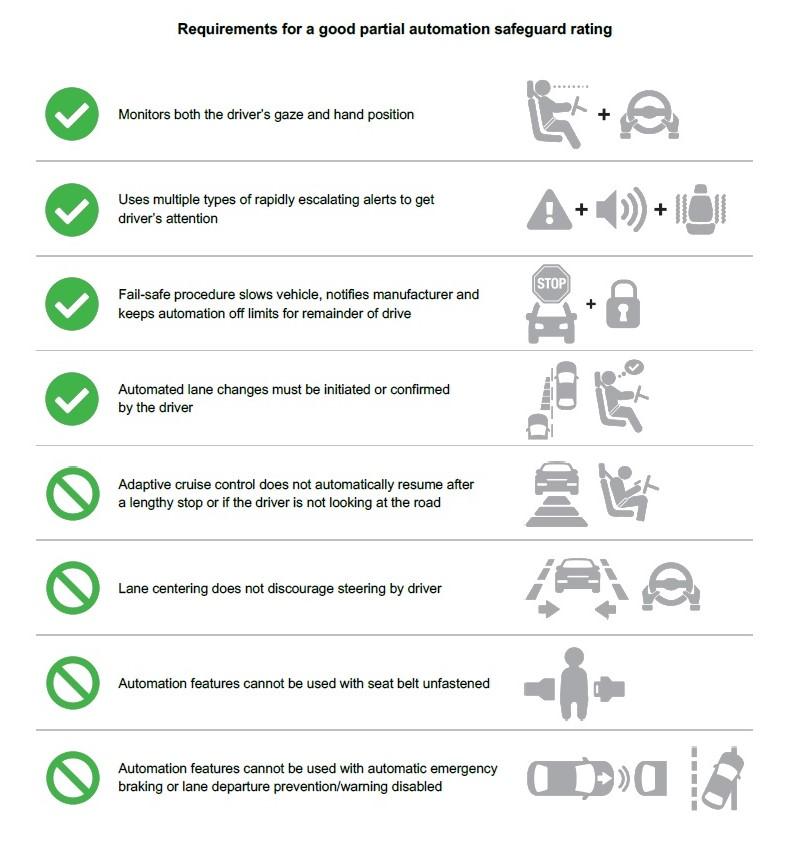The insurance industry in the U.S. is cracking down on autonomous vehicle safety and is developing a new ratings program for vehicles equipped with partial automation to alert drivers to stay focused on road safety.
Ratings will be set later in 2022 to levels of good, acceptable, marginal or poor, according to the Insurance Institute for Highway Safety.
A good rating will mean vehicle systems are in place to ensure a driver’s eyes are directed on the road and their hands are either on the wheel or ready to grab it at all times. If the driver doesn’t meet those conditions, a vehicle must provide escalating alerts and emergency procedures to protect the driver and others.
“Partial automation systems may make long drives seem like less of a burden, but there is no evidence that they make driving safer,” said IIHS President David Harkey in a statement issued Thursday. “In fact, the opposite may be the case if systems lack adequate safeguards.”
IIHS said some manufacturers have provided “misleading information” about the level of automation in today’s new cars, adding that currently there are no self-driving cars available to consumers.
What is currently available in the latest vehicles is only partial automation such as autopilot, pilot assist and super cruise that use cameras, radar and sensors to see the road. Multiple models of today’s vehicles combine adaptive cruise control (ACC) with lane centering, for example. ACC keeps a driver-selected speed but automatically slows to keep a pre-set following distance from a slow-moving vehicle ahead but will accelerate when the way becomes clear, IIHS noted. Lane centering adjusts the steering to help the driver keep the vehicle centered.
Under current technology, the most advanced systems require active supervision by drivers. IIHS said some manufacturers “have oversold the capabilities of their systems, prompting drivers to treat the systems as if they can drive the car on their own.”
The IIHS statement comes amid a flurry of investigations by U.S. federal and state authorities in the past two years into accidents and deaths involving vehicles with Level 2-plus partial automation, including some Tesla models. Level 4 automation set by the Society of Automotive Engineers (SAE) is considered high automation and is envisioned in some vehicles to hit the roads by 2025. None of the current partial automation systems in today’s vehicles meet all the pending IIHS criteria for safety.
IIHS noted that some drivers of partially automated vehicles have been documented watching videos or playing games on cellphones or even taking naps while speeding down the highway. IIHS took note of the fatal crash involving a Tesla Model X in Mountain View, Calif, in 2018 . The U.S. National Transportation Safety Board investigated and found that the driver was most likely distracted by a cellphone video game when the vehicle’s autopilot system accelerated into a highway crash barrier.
“The way many of these [partial automation] systems operate gives people the impression that they’re capable of doing more than they really are,” said IIHS Research Scientists Alexandra Mueller. “But when drivers understand the limitations of partial automation, their minds can still wander. As humans, it is harder for us to remain vigilant when we’re waiting for a problem to occur than it is when we’re doing all the driver ourselves.”
IIHS wants to encourage technology safeguards to help reduce intentional or unintentional misuse of a partially automated vehicle. A good rating will be earned for vehicles that use multiple alerts to remind the driver to look at the road and put their hands on the wheel. Alerts could include chimes, vibrations, pulsing brakes or a tug on a driver’s seat belt. If a driver doesn’t respond, the car’s system should slow it to a crawl or stop and notify a manufacturer’s concierge or assistant who can call emergency services and the driver should be locked out of the system until the engine is switched off and started again.
The IIHS criteria is also calling for all automated lane changes to initiated or confirmed by the driver. And when traffic causes cruise control to bring the vehicle to a stop, it should not start automatically driving again if the driver is not looking at the road or the vehicle has been stopped for a longer period. Also, lane centering technology should encourage the driver to share in the steering rather than switching off automatically when the driver adjusts the wheel, which IIHS said discourages drivers from participating in the driving tasks.
Also systems should be created to prevent drivers from using partial automation when seat belts are unfastened or when automatic emergency braking or lane departure prevention is disabled, IIHS said.
IIHS is an independent organization wholly supported by auto insurers. The organization began examining driver assistance features with track tests as early as 2018.

RELATED: Tesla’s expanded self-driving system earns NTSB chair’s scorn